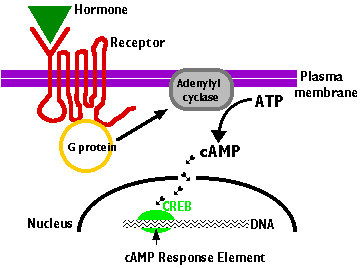What makes few people abnormally tall while others are abnormally short? How is it that somedays you are in a good mood whereas the other days your mood is not as good? The correct answer is hormones. The growth hormone in excess during the growth years gives rise to gigantism whereas a deficiency of it in the growth years results in dwarfism. Estrogen makes a woman feel good below levels of it can make them cranky. All these are effects of hormones. Let us more about them.
Suggested Videos
What are Hormones?
Hormones are chemical messengers that are produced by the endocrine glands and are released into the bloodstream directly instead of through ducts. They regulate various body functions such as growth, reproduction, digestion, etc. They are of two types based on their chemical composition:
- Protein Hormones- These hormones are soluble in water. E.g. Adrenaline, Noradrenaline
- Steroid Hormones- These hormones are not soluble in water. E.g. thyroid hormone
Since the protein hormones are soluble in water, they are easily transported in the blood. The steroid hormones which are not water soluble bind to plasma proteins and are transported to their target organs.
Browse more Topics under Chemical Coordination And Integration
Mechanism of Hormone Action
Before we understand the mechanism of hormone action, let’s look at what are hormone receptors. Each hormone has receptors that are found on the cell membrane of the target organ. Once the hormone bind to its designated receptor, a series of actions are initiated to release secondary messengers inside the cell. These secondary messengers are responsible for relaying information to the nucleus or other organelles. Based on their structure, receptors are of different types:
Internal receptors– they can be either nuclear or cytoplasmic. Nuclear receptors are found on the nuclear membrane while the cytoplasmic receptors are found in the cytoplasm of the cell. These receptors are for the steroid hormones.
External receptors– These are the transmembrane receptors which are embedded in the lipid layer of the cell membrane. These receptors are for the protein ones.
The mechanism of action hormone can be of two types: First, where the receptors are fixed and the second, where the receptors are mobile.
Fixed Receptor Mechanism

(Image Source: biology-spaces.info)
This mechanism of action hormone is seen in the protein hormones such as Adrenaline, insulin, ADH, TSH etc. As mentioned earlier, since they are water soluble, they cannot pass through the cell membrane as it is made up of a lipid layer. So, they bind to their extracellular receptors present on the membrane.
Once the protein hormone binds to the receptor, a series of reactions occur beginning with the production of adenyl cyclase enzyme. This enzyme leads to the production of cyclic AMP or cAMP which is the secondary messenger. This cAMP can now enter the cell and cause the effect it was meant to bring about.
Mobile Receptor Mechanism

(Image Source: stmary.ws)
This kind of mechanism is seen in the steroid hormone that is insoluble in water. They are made up of fats and therefore can freely cause the lipid layer of the cell membrane. Their receptors are intracellular and not extracellular like those for the protein ones. The intracellular receptors can be floating in the cytoplasm, on the nuclear membrane or inside the nucleus. For this reason, their receptors are known as mobile receptors.
Question for You
Q: Which is a secondary messenger of the mechanism of hormone action?
(a) ATP (b) cAMP
(c) Proteins (d) lipids
Sol. (b) cAMP
cAMP or cyclic AMP is a common secondary messenger that participates in the hormone action. Once the hormone attaches itself to the extracellular receptor, a series of reactions begin and lead to the formation of cAMP which acts as the secondary messenger.






Leave a Reply